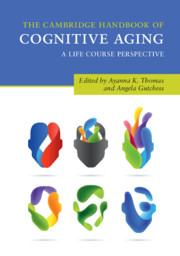Book contents
- The Cambridge Handbook of Cognitive Aging
- The Cambridge Handbook of Cognitive Aging
- Copyright page
- Contents
- Figures
- Tables
- Contributors
- Introduction
- Part I Models of Cognitive Aging
- Part II Mechanisms of Cognitive Aging
- Part III Aging in a Socioemotional Context
- Part IV Cognitive, Social, and Biological Factors across the Lifespan
- Part V Later Life and Interventions
- 32 Cerebrovascular Disease, Aging, and Depression: Clinical Features, Pathophysiology, and Treatment
- 33 The Role of Nutrition in Cognitive Decline
- 34 The Role of Sleep in Cognitive Aging
- 35 The Relationship between Accelerometer-Derived Metrics of Physical Activity and Cognition among Older Adults
- 36 Far Transfer and Cognitive Training: Examination of Two Hypotheses on Mechanisms
- 37 Maximizing the Impact of Cognitive Engagement Interventions for Older Adults
- 38 Mobility and Cognitive Decline in Older Adults with Cognitive Impairment
- 39 Current and Emerging Technologies for Supporting Successful Aging
- Part V Summary: Later Life and Interventions
- Index
- Plate Section (PDF Only)
- References
35 - The Relationship between Accelerometer-Derived Metrics of Physical Activity and Cognition among Older Adults
from Part V - Later Life and Interventions
Published online by Cambridge University Press: 28 May 2020
- The Cambridge Handbook of Cognitive Aging
- The Cambridge Handbook of Cognitive Aging
- Copyright page
- Contents
- Figures
- Tables
- Contributors
- Introduction
- Part I Models of Cognitive Aging
- Part II Mechanisms of Cognitive Aging
- Part III Aging in a Socioemotional Context
- Part IV Cognitive, Social, and Biological Factors across the Lifespan
- Part V Later Life and Interventions
- 32 Cerebrovascular Disease, Aging, and Depression: Clinical Features, Pathophysiology, and Treatment
- 33 The Role of Nutrition in Cognitive Decline
- 34 The Role of Sleep in Cognitive Aging
- 35 The Relationship between Accelerometer-Derived Metrics of Physical Activity and Cognition among Older Adults
- 36 Far Transfer and Cognitive Training: Examination of Two Hypotheses on Mechanisms
- 37 Maximizing the Impact of Cognitive Engagement Interventions for Older Adults
- 38 Mobility and Cognitive Decline in Older Adults with Cognitive Impairment
- 39 Current and Emerging Technologies for Supporting Successful Aging
- Part V Summary: Later Life and Interventions
- Index
- Plate Section (PDF Only)
- References
Summary
Aging is associated with cognitive decline. The extant literature suggests that exercise positively impacts multiple cognitive domains or at least attenuates the rate of decline among nondemented older adults, but less is known about the broader cognitive impact of daily physical activity (that may or may not fall under the definition of exercise). Evolving technologies have ushered a new wave of research that objectively measures physical activity, providing a metric that is more precise and avoids some of the limitations of self-report data. In this chapter, we briefly review studies examining the relationship between objectively measured physical activity and cognition among older adults. We highlight the current state of the literature on aging, cognition, and wearable technologies that objectively assess physical activity. Our review revealed several cross-sectional studies that show a significant and positive association between overall and specific intensities of physical activity and cognition among older adults. Longitudinal studies indicated that physical activity positively impacts cognitive performance and thus support the notion that physical activity may protect against age-related cognitive decline. Moreover, the extant literature suggests that physical activity may preferentially benefit executive function, processing speed, and episodic memory. Further research on the objective assessment of physical activity and cognition will help identify the precise amount and intensity of daily physical activity that confers optimal cognitive benefits and may inform activity prescriptions for optimal cognitive aging.
Keywords
Information
- Type
- Chapter
- Information
- The Cambridge Handbook of Cognitive AgingA Life Course Perspective, pp. 645 - 665Publisher: Cambridge University PressPrint publication year: 2020
References
Accessibility standard: Unknown
- 1
- Cited by
